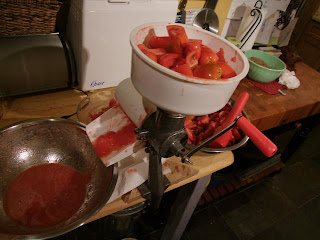If the thought of canning food conjures up images of Grandma in an apron, sweating over a pot of boiling water in a hot kitchen in late summer, jars littering the kitchen counters... you're about right. If you're just putting up a few jars of pickles or preserves, canning is probably a rather enjoyable and relaxing experience, in a fun, "Hey, look at me, I'm retro!" kind of way. But if you're canning to preserve this year's harvest through the next... refer back to Image A.
Don't get me wrong - canning is not difficult. It is, however, time consuming, and, well,
hot. The majority of produce comes into season during the hottest months, and no matter how high you crank up the A/C, a few hours with pots of boiling water and simmering food in an enclosed space = SAUNA. (At least it's good for my pores, right?) But with a little forethought and some practice, you, too, can become an efficient canner.
So why do I subject myself to the very real possibility of melting? Believe me, the bounty you have preserved for the coming year makes it so very worthwhile. We have the ability to preserve fresh fruits and vegetables at their peak ripeness (which also means when they are at their cheapest), so we can enjoy them all year round; since we lean towards being
locavores, you won't find us eating much out of season. That may seem crazy to restrict ourselves like that, but does anyone really enjoy the insipid taste of a peach in December, or strawberry in January, especially after paying a premium for them (to be shipped in from South America, I might add)? Not I, said the Peters Family. I'd much rather freeze or can a perfectly ripe strawberry, eat it in the dead of winter, and remember why I love May so very much. Those of you who know us know, as well, we're pretty big on the "made from scratch" thing. If I can make my own pickles, salsa, jam, tomato sauce, et. al., then I most certainly will. They provide me the opportunity to make use of local raw ingredients. They have less ingredients, and I know what each of those ingredients are, and where they came from. They do not require chemical preservatives. They show some extra love. And hot damn if they don't taste better, too. I'm also preserving a food tradition that used to be a way of life.
So surely after that rousing speech, you, too, want to can, right?
Equipment you'd need:
1) A canner: Here's where you will have to make your first choice, based on what you plan to can.

The simplest is a water bath canner - essentially a very large, deep pot with a wire cage at the bottom (to hold the jars off the bottom of the pot). If you plan on canning just a few jars, you can accomplish the same with any large stock pot you already have - just make sure it's deep enough to cover the jars with about an inch of water, and to add some type of wire cage to the bottom. This type of canner can be used for any foods which contain some sort of acid - pickles, fruit based items, tomato sauce, etc. A water bath canner does not get hot enough to safely seal foods which are not acidic (green beans in water, for example).
My inherited water bath canner (see, it doesn't have to be fancy
at all):
If you plan to can items which are not acidic, then you will need a pressure canner.
2) Canning jars (a.k.a.,
Mason jars). The most common brands are Ball and Kerr, and you can find them in most big chain grocery stores (look in the seasonal or foil/baggie/plastic wrap aisle).
3) Food to can.
Seriously, that's about it.
The number one thing that I have learned this year is to separate - process the food one day, can it the next. Rather than spending all night in the kitchen, peeling, coring, and then cooking apples into sauce, and then immediately turning around to can them, it turns out it's much easier to make the applesauce one night, and can it the next. Ah ha! Talk about a light bulb moment. You'll have to reheat the sauce before canning (to help guard against botulism), but that's easy enough to do while you're sterilizing your jars.
Following that route, your basic steps are:
1) Prepare your food.
2) Sterilize your jars and lids (heat them in the canner for about 10 minutes).
3) Fill your jars (both the jars and, in most cases, the food, should be hot).
4) Place the filled jars in the canner for the appropriate amount of time, depending on the food inside and the size of the jars.
Since this isn't really intended to be a step by step how to, that's about all I will give you. I highly recommend picking up a booking on canning, such as the
Ball Complete Book of Home Preserving. You can get recipes and tips from those far more experienced than I.
As I alluded to above, I may have gone a little crazy when it came to the fruit this year. In past years, I've done some fruit jams and sauces, and various pickles, and that was about it. This past winter was long, and by doing my best to stick to the more in season fruits (which isn't much in Wisconsin during winter!), I was seriously fruit deprived come spring, which you must remember for us in Wisconsin is actually June. Thus between freezing and canning, we have a lot of fruit to enjoy this winter. A
lot. Including the 60 lbs (not a typo) of strawberries we variously froze and canned, I have canned:
- nectarines in white grape juice
- peaches in white grape juice
- plums in white grape juice
- apricots in white grape juice
- fruit cocktail in white grape juice
- cherries in syrup
- strawberry syrup
- strawberry preserves
- peach preserves
- applesauce (chunky plain, cinnamon, and strawberry)
- pureed applesauce (for baby)
- pureed peaches (for baby)
- chow chow (a summer squash relish - both sweet and spicy versions)
- bread and butter pickled jalapenos
-
dill pickles (both cucumber and zucchini)
- spicy dill pickles (using the above recipe and adding cayenne peppers to the jars)
- salsa (mild, medium, and hot)
I have yet to do pears... and peppers haven't fully come in yet... and there is another bowlful of apples to deal with... and I found some interesting pickled radish recipes... and this list does not account for the fruit and vegetables we have froze (and have yet to freeze). And since I have recently discovered that I can indeed can baby food, I figure I have a few dozen more half pints of pears, plums, and the like to put up. Thankfully, Mom and Dad have a pear tree, so I have ready access to at least a couple hundred pounds of pears (stop groaning, Bryan, I promise I won't pick them all!).
Let's just say recently in our house, "I am not going to can any more fruit!" is very quickly followed by "Hey, I could can that!" My mantra as I am standing on sore feet in a 200
°F kitchen (while 29 weeks pregnant, mind you), has been "We will be so happy in the winter. We will be so happy in the winter. I'm so hot I could cry - no, no! - We will be so happy in winter!"
I swear I'm not crazy though. I can't prove it to you yet... but wait until December.
 |
| (that's 3 layers deep, folks) | | |
|
Nope, not crazy at all.













































